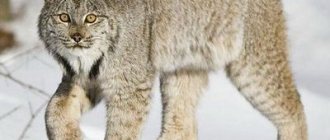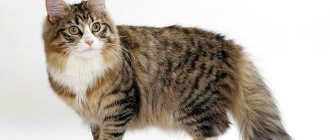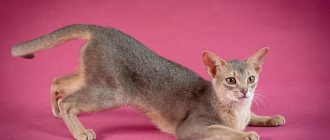Save the article:
The Turkish word “karakulak” - “black ears”, gave the world the name of a species of predatory cat breed, whose erect ears with tassels strongly distinguish the croak cat .
The caracal is a wild cat that prefers a free, free life in semi-deserts and steppes. Initially, this small predator was used as a hunting animal by many peoples of Africa. Today, the beautiful and intelligent steppe lynx has proven that it is capable of becoming a friend in the family and living life in an enclosure or a spacious house side by side with a person.
Description
The coat color varies from brown to red. Females are generally lighter than males. The belly is white and, like African golden cats, decorated with many small spots. Vertical dark lines extend above the eyes. A distinctive feature of the species are elongated ears with black bones. The legs are relatively long, the hind limbs are longer than the forelimbs, and have well-developed muscles. Eye color varies from golden or copper to green or gray. Melanism has been documented in individuals of this species, but is extremely rare. Juveniles are distinguished by their shorter ear tufts and blue eyes. Females weigh no more than 13 kg, while males can weigh up to 20 kg. Even though the tail is short, it still makes up a significant portion (18 to 34 cm) of the total body length including the head (62 to 91 cm). Even the smallest adult caracal is larger than most domestic cats.
Subspecies
- C. c. algira – Algeria, Libya, Morocco, Tunisia;
- C. c. caracal – central Africa and South Africa;
- C. c. damarensis – Namibia;
- C. c. limpopoensis – Botswana and northern South Africa;
- C. c. lucani – northern Angola, Democratic Republic of the Congo, Gabon and Republic of the Congo;
- C. c. nubica – Cameroon, Ethiopia and southern Sudan;
- C. c. poecilotis – Senegal, Nigeria, Niger and western Sudan;
- C. c. schmitzi - Afghanistan, western India, Iran, Iraq, Israel, southwestern Kazakhstan, Kuwait, Lebanon, Oman, Pakistan, Qatar, Russia, Syria, southern Turkey, Turkmenistan, UAE, southwestern Uzbekistan.
Caracal hybrid breeds
Caracat – Felinologists tried to cross a caracal cat and a domestic cat. The result was a hybrid called caracat. The breed was founded in 1998 in Moscow, and further selection was carried out by specialists in the USA. In 2007, an Abyssinian cat gave the world a caracal kitten. The process stalled, and already the Russian woman Irina Nazarova took up the breeding of caraquets and achieved recognition of the breed by the Russian International Registry ICU and the International Cat Organization TICA.
Habitat
Caracals occupy a variety of habitats. Typically, they are found in wooded areas, thickets and bushes, plains and rocky slopes. These cats prefer the outskirts of their habitats, especially forest/meadow crossings. Steppe lynxes are found at altitudes of over 3,000 meters in the mountains of Ethiopia. An arid climate with minimal leaf cover is preferred. Compared to servals, caracals can live in drier conditions. However, they rarely live in desert or tropical areas. In Asia, they are sometimes found in forests, which is rare for African populations.
Domestic cat caracal
global $ads_google; //data-ad-slot=”2475549904″ $ads_google = empty($ads_google) ? false : true; ?> if ($ads_google == false) {?>
$ads_google = true; ?> } ?>
If you want to have a caracal in your home, it is worth exploring the possibilities of keeping such a pet at home. The cat loves space, so a free enclosure is built for her or purchased only for spacious houses.
In the enclosure, the animal will need shelter to rest. If a caracal cat lives in a house, then it quickly gets used to the company of its owners and is not burdened by them. You can combine a house and an enclosure, giving the cat the opportunity to walk freely in it.
Owners love the animal's love of bathing - a bath becomes a shared pastime. Wash the domesticated steppe lynx with hypoallergenic shampoo. Kitties quickly get used to the silicone comb and learn to cut their claws.
Caracal kittens are litter trained from childhood, and they quickly get used to a permanent toilet. Since the individual is not small, the appropriate tray is selected.
Domestic caracals should be dewormed and receive annual vaccinations. The immunity of these cats is impeccable, and with proper care the cat will please its owners for 15-18 years, remaining vigorous and active.
Buy a caracal
buy a caracal kitten not just anywhere, but in a nursery that specializes in them. There are nurseries that breed only rare breeds of cats. If you are offered a kitten by hand, without certificates, then it is quite possible that this animal was torn from its mother by poachers.
There are several nurseries in the world, including in Moscow, where you can find the desired domestic caracal. The price for a predator is at least 400,000 rubles
Reproduction
Before mating begins, chemical signals in the female's urine attract the male and notify him that she is ready to mate. The distinctive cough-like vocalization is also a way of attracting mates. Several different forms of mating systems characteristic of the species have been observed. When several males are courting a female, there may be a struggle between them for the right to mate, or the female may choose a partner on her own, preferring older and larger ones over young and small ones. Once paired, caracals stay together for four days and mate frequently. Copulation lasts on average less than five minutes. Cats almost always mate with more than one male. For males, infanticide is observed, after which the female, prematurely, begins estrus and ends lactation.
Although both sexes become sexually mature at 7–10 months, the earliest successful mating occurs at 14–15 months of age. Some biologists believe that sexual maturity is indicated by a body weight of 7 to 9 kg. Females exhibit estrus behavior for 3 to 6 days, but in reality, it lasts twice as long. Estrus can begin at any time during the year. Pregnancy lasts 68 - 81 days, and the number of kittens in the litter varies from 1 to 6. In the wild, as a rule, no more than 3 cubs are born, while in captivity, there are more of them, but rarely exceed 6 kittens.
Parental education plays a large role in reproductive behavior. The time a mother spends with her kittens (and the absence of postpartum estrus) limits the female to one litter per year. Once pregnancy occurs, the male plays no role in rearing. Mothers invest a lot of time and energy into their offspring. Holes in trees, caves, or abandoned burrows are often chosen for the birth of young and the first four weeks of their lives. A month later, the cubs come out of hiding. Around this time, kittens begin to play and eat meat. Breastfeeding continues until the kittens reach 15 weeks of age, but full independence occurs at 5 to 6 months.
Nutrition
Like other cats, caracals are strictly carnivores. The diet includes: hyraxes, hares, rodents, antelopes, small monkeys and birds. Pigeons and partridges are seasonally important prey. Mountain rednuck, Dorcas gazelle, Great Bustard, common gazelle, gerenuk and Sharp's stenbok are specific examples of animals that steppe lynxes can hunt. They consume some reptiles, although reptiles are not the main component of the diet. Depending on their habitat, the components of their diet change. For example, the African caracal can feed on larger species, such as ungulates, while the Asian caracal can only feed on small vertebrates (for example, rodents). Sometimes they attack domestic animals. Although these cats are known for their spectacular leaps at birds, mammals make up more than half of the diet in all habitats. They can kill prey two to three times their body weight. Small victims are killed by a bite to the back of the head, and large victims are killed by a bite to the throat. Caracals chase prey and then leap on it using their disproportionately long and muscular hind legs. Unlike leopards, they rarely lift a dead carcass into trees.
Dash between clauses
Dash between subject and predicate
1. noun –
2. undefined form ch. – undefined Ch. Form
3.number – number.
4. noun – ↔ undef. Ch. Form
Note:
A dash is placed ONLY when there is a logical emphasis on the subject or predicate
1) personal pronoun - noun
2) noun – not+ noun.
The most beautiful thing in the world is a mother's eyes
Five and six are eleven
Talking too much will only harm the cause
The road going through the forest is the shortest distance to the station
Class is your bazaar (compared to Union)
A drop of honey is like a pearl
Heart stone
Learning does not mean imitating something
The steppe lynx, or caracal, is a resident of the plains
A dash is placed
1) between two homogeneous members of a sentence, not connected by conjunctions, to express sharpness, opposition
Nr: They don’t live here – it’s paradise
2) before the conjunction And, connecting two homogeneous predicates, if the second of them contains a consequence of what is indicated in the first predicate, or expresses a sharp opposition, or communicates something unexpected
Example: The army invaded - and at six o’clock in the afternoon I saw the enemy among the vast field of Kulikov
Note: to enhance the connotation of surprise, a dash can be placed after the conjunction I.
Example: asking for payment on Saturday and marching to the village
Dash between subject and predicate.
1. A dash is placed between the subject and the predicate:
with a zero connective (i.e. in the absence of a linking verb), while the subjects and predicate are expressed by a noun or a cardinal numeral in the nominative case, an infinitive. (My mother is a teacher.)
if the predicate is preceded by the words this, that means it means (Defending the Motherland is our duty.)
2. There is no dash between the subject and the predicate:
if comparative conjunctions are used as a connective: as if, as if, exactly, like, etc. (This house is like a block.),
if the subject is expressed by a personal pronoun (the dash in this case is considered as the author's) (She is a ballerina.),
if the predicate is preceded by a negative particle not (Poverty is not a vice.),
if the predicate is preceded by a secondary member of the sentence that is not consistent with it (Plato is my friend, but the truth is more precious.),
if between the main members of the sentence there is an introductory word, adverb or particle (Ivan is also a student. His father, apparently, is an engineer.),
in conversational style sentences (His brother is a student.).
A dash in an incomplete sentence.
A dash is placed in an incomplete sentence if a predicate (most often) or some other part of the sentence is missing, but it can be easily restored from the context or from the situation (She went home, he went to the cinema),
If for a sentence the absence of a predicate is the norm, then a dash is not placed (the predicate is implied and can be easily guessed from the content of the sentence itself): Again, at the hour of a night cloud above the ground.
Intonation dash.
1. An intonation dash is placed at the point where a sentence breaks down into word groups in order to emphasize the semantic relationships between the members of the sentence and help the reader correctly connect words according to meaning (Children need to explain.)
Connecting dash.
1. A dash is placed:
between words to designate a certain space (train Nikolaev - Moscow), quantity (buy two or three kilograms of sweets) or a period of time (Revolution of 1905-1907), if it replaces the meaning of the construction “from ... to”,
between proper names, the totality of which is some name (of a teaching, scientific institution, etc.): the Boyle-Mariotte law, the match “CSKA - Lokomotiv”.
Separating definitions and applications
Definitions
Separated:
1. With dependent words coming after the word being defined
I stood alone on an icy platform, lost among the steppes of Bashkiria.
2. Two or more after the word being defined
Through the juniper, gnarled and unkempt, a luxurious, beautiful lungwort sprouted and blossomed in the light.
3. Related to a personal pronoun
He stands, pale, in the middle of the highway.
4. Standing before a defined noun and having an additional adverbial meaning
Deafened by the heavy roar, Terkin bowed his head.
5. Separated from the defined noun by other members of the sentence
Not separated:
1. With dependent words standing before the word being defined, if they do not have additional adverbial shades of meaning
The sparrow flew under the dome of the hall, sat down on the chandelier and began to clean the feathers disheveled in the fight.
2.If in meaning they are connected not only with the subject, but also with the predicate and are part of it.
Marya Ivanovna came to dinner pale and tear-stained.
3. With dependent words after the indefinite pronoun
From the darkness of the branches something terrible, dark and cold looked at those walking.
4. Expressed by a participial with dependent words, if they relate to a defining, demonstrative and possessive pronoun.
Applications
1) If the application refers to a common noun, then it is isolated in any case, regardless of its place in the sentence. For example:
My father, captain of the border troops, served in the Far East and Captain of the border troops, my father served in the Far East.
2) If the application refers to a proper noun, it is isolated only when it comes after it. For example:
Ivanov, captain of the border troops, served in the Far East and Captain of the border troops Ivanov served in the Far East.
3) If the application refers to a personal pronoun, then it is isolated in any case, regardless of its place in the sentence. For example:
He, captain of the border troops, served in the Far East and captain of the border troops, he served in the Far East.
This rule has a few notes:
1. Sometimes an application that is given great importance in a statement and which stands at the end of a sentence can be separated with a dash rather than a comma, for example: August was coming to an end - the last month of summer.
2. Sometimes an application may begin with the conjunction HOW. In such cases, you should try to replace this union with the combination IN QUALITY. If such a replacement is possible, then there is no need to put commas. For example: Gas as a fuel is now used very widely. The rules for placing commas before the conjunction HOW will be discussed in more detail in a separate part of our course.
Behavior
These animals can go without drinking for a long time. During the hot hours of the day, they rest, and hunt mainly during the cold hours - morning, night and evening. Their gait is similar to that of cheetahs, but they are not sprinters. Steppe lynxes climb trees if they are being chased by dogs. Although they can be considered the fastest cats in their weight class, when hunting, they sneak quietly and then jump on their prey like house cats.
Caracals are wonderful jumpers and can jump up to 3 meters in height. Thanks to this feature, cats can knock birds to the ground with their paws. They are capable of killing ten to twelve pigeons in one hunt. Once upon a time, these predators were domesticated and trained to hunt birds in India and Iran. They were placed in an arena containing a flock of pigeons, and people placed bets on the number of birds shot down. Caracals were also used to hunt antelope, hares and foxes, as well as cheetahs.
Like most cat species, steppe lynxes are nocturnal and travel up to 20 km per night in search of food. They sleep in burrows, crevices or dense bushes, sometimes in trees.
Home range
Caracals have a fairly large home range for their relatively small body size. Climatic conditions, geographic location and breeding ability are the main factors influencing the size of the home range of individuals. The male's territory is usually twice as large as the female's. The size of the home range also depends on the availability of water. In areas with dry climates, the home range is much larger. In some parts of Africa, a male's territory ranges from 31 to 65 km². Females in the same region will maintain a range of 4 to 31 km². In some parts of Asia, males have home ranges of 200 to 300 km². A male's territory may overlap the ranges of several other males, while a female defends her entire territory for her individual use.
Lifestyle of caracals
Predators prefer a nocturnal lifestyle to a daytime one. Their life is spent in rock crevices, burrows of foxes and porcupines, where they hide during the day. The same shelter can be occupied by a cat for several years in a row. Large territories belong to males, females have enough of the periphery.
Water is not a hindrance for them; the steppe lynx can easily swim across a small lake. You can’t hide from the beast even in a tree—it’s also a convenient place for caracals .
In spring and winter, wild cats can be seen during the daytime.
A cat hunts not by running after its prey, but by sneaking up on it and overtaking the prey with long jumps. The caracal jumps up to 4.5 m in length and 3 m in height. The retractable claws are so sharp and the animal's speed is high that sometimes the hunter simultaneously grabs several birds in a flock.
The cat does not leave its prey on the ground, but drags it to the nearest tree, so that in case of danger it does not risk the captured food.
Communication and perception
There has never been a thorough study of the communication of this species. Most of the information comes from observing individuals kept in captivity. Like other cats, caracals have well-developed senses of hearing and vision. Although servals are known for their incredible hearing, steppe lynxes can also, alone, detect small prey by sound. Once prey is located, they use their keen vision to focus on it. The exact function of the ear tassels is unknown. In captivity, caracals are known for their vocalizations. These cats growl, hiss, spit and meow. Tactile communication is observed in combat, between males, and during the breeding season. A potential partner is attracted to an olfactory signal. Hormonal changes in the female's body lead to changes in the composition of urine. When the female is ready to mate, she marks her territory with her urine, in different places, to attract males, who sense the scent through the vomeronasal organ.
Character of the desert lynx
It is difficult to judge the character of a wild cat in relation to humans. But if you domesticate an animal, you will have to face many difficulties. A person with a big heart and a strong will can cope with the freedom-loving character of the karkal. In order for a cat to demonstrate affection, understanding and obedience, the same training as for puppies of large breed dogs will be required.
Reviews about domesticated caracals are positive: cats quickly learn their new role as a member of the human family and behave with dignity. However, you should not expect the behavior of a soft domestic kitty; after all, this is a wild animal, in whose genes there is a thousand-year memory of nature.
Threats
Despite their widespread distribution and relatively large overall population size, in some parts of their range, caracals are considered rare and endangered. Because they are capable of attacking domestic animals, they are often seen as a problem across the spectrum. In North Africa, Arabia, Central Asia, Iran and India, habitat loss poses a serious threat to the survival of this species. In southern Africa, where steppe lynxes are common, they are heavily persecuted as pests due to their habit of preying on domestic animals. However, despite the large number of individuals killed, the population does not seem to be suffering.
Coat color is the main defense against predators. When threatened in open habitats, caracals lie flat on the ground and their smooth, brown fur acts as instant camouflage. Agile tree-climbing abilities help avoid large predators such as lions and hyenas.
Known predators:
- lions (Panthera leo);
- leopards (Panthera pardus);
- hyenas (Hyaenidae).
Economic significance for humans
Positive
In India and Persia, they were once trained to catch game and deer. Thus, cats provided people with food and entertainment. The meat and hides in West and Central Africa provide food and modest income for local people. Fortunately for caracals, their skin is in very low demand.
Negative
Predation on small domestic animals leads to the destruction of thousands of steppe lynxes every year. This is particularly the case in South Africa and Namibia, where predator control programs are lacking.
Captivity
The caracal's willingness to be tamed has long been noticed. Therefore, even now, exotic lovers buy a wild cat as a pet. No matter how beautiful and affectionate a cat may seem, it is always worth remembering that the caracal is first and foremost a predator. And being kept in captivity is still atypical for him.
Usually, an enclosure or shelter is set up for steppe lynxes, where the animal can rest. Since the caracal needs walks in the fresh air, a private house with a spacious enclosure would be an ideal place of residence for it. Otherwise, the pet must be walked on a harness. Preferably, away from areas with dogs and crowded places. You should not allow a caracal to run without a leash outside the enclosure - this is dangerous.
Just like for an ordinary cat, a tray is purchased for the steppe lynx. True, a little larger in size. You can fill it with either silica gel or wood shavings and granules. The animal quickly understands what the container is for. Daily cleaning and regular change of litter will help to avoid the unpleasant odor characteristic of cats.
You will have to pay a lot of attention to the appearance of the caracal. Animals shed almost all year round, but their fur falls out most actively in the summer. Dead hairs should be removed with a brush (rubber) and your hand (after putting on gloves).
You need to trim your nails periodically. Nippers designed for dogs are suitable for this procedure. Caracals love water, so they can be bathed from time to time. It is recommended to wash the fur with cat shampoo.
Of course, we should not forget about mandatory vaccinations, vaccinations against rabies and parasites. It is better to consult your veterinarian about the specifics of these procedures. Caracals have a fairly strong immune system, so with proper care and feeding they can live up to 15 years.
Security status
The Convention on International Trade in Endangered Species (CITES) lists the Asian populations in Appendix I and all others in Appendix II. This means that Asian populations cannot be traded for any commercial gain, but trade for scientific research is permitted. Appendix II dictates that trade in these animals will be controlled and permitted in cases that will not be detrimental to the species.
According to the IUCN Red List, steppe lynxes are classified as a species of Least Concern.











